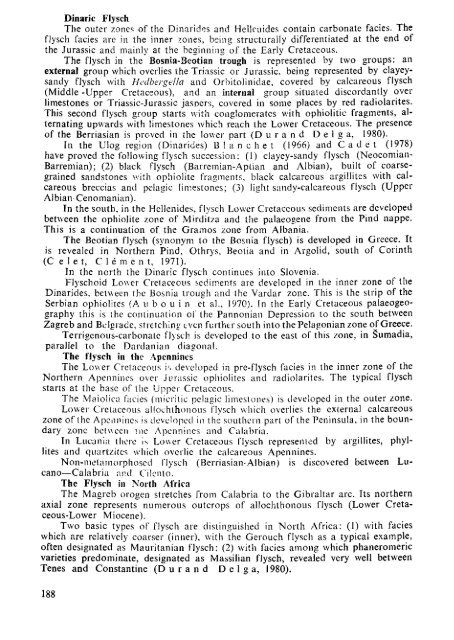THE MEDITERRANEAN LOWER CRETACEOUS
THE MEDITERRANEAN LOWER CRETACEOUS
THE MEDITERRANEAN LOWER CRETACEOUS
Create successful ePaper yourself
Turn your PDF publications into a flip-book with our unique Google optimized e-Paper software.
Dinaric Flysch<br />
The outer zones of the Dinarides and Hellenides contain carbonate facies. The<br />
flysch facies arc in the inner zones, being structurally differentiated at the end of<br />
the Jurassic and mainly at the beginning of the Early Cretaceous.<br />
The flysch in the Bosnsa-Beotian trough is represented by two groups: an<br />
external group which overlies the Triassic or Jurassic, being represented by clayeysandy<br />
flysch with Hedbergella and Orbitolinidae, covered by calcareous flysch<br />
(Middle -Upper Cretaceous), and an internal group situated discordantly over<br />
limestones or Triassic-Jurassic jaspers, covered in some places by red radiolarites.<br />
This second flysch group starts with conglomerates with ophiolitic fragments, alternating<br />
upwards with limestones which reach the Lower Cretaceous. The presence<br />
of the Berriasian is proved in the lower part (Durand Delga, 1980).<br />
In the Ulog region (Dinarides) Blanche! (1966) and Cadet (1978)<br />
have proved the following flysch succession: (1) clayey-sandy flysch (Neocomian-<br />
Barremian); (2) black flysch (Barremian-Aptian and Albian), built of coarsegrained<br />
sandstones with ophiolite fragments, black calcareous argillites with calcareous<br />
breccias and pelagic limestones; (3) light sandy-calcareous flysch (Upper<br />
Albian Cenomanian).<br />
In the south, in the Hellenides, flysch Lower Cretaceous sediments are developed<br />
between the ophiolite zone of Mirditza and the palaeogene from the Find nappe.<br />
This is a continuation of the Gramos zone from Albania.<br />
The Beotian flysch (synonym to the Bosnia flysch) is developed in Greece. It<br />
is revealed in Northern Pind, Othrys, Beolia and in Argolid, south of Corinth<br />
(С e 1 e t, Clément, 1971).<br />
In the north the Dinaric flysch continues into Slovenia.<br />
Flyschoid Lower Cretaceous sediments are developed in the inner zone of the<br />
Dinarides. between the Bosnia trough and the Vardar zone. This is the strip of the<br />
Serbian ophiolites (A ti b о u i n et al., 1970). In the Early Cretaceous palaeogeography<br />
this is the continuation of the Pannonian Depression to the south between<br />
Zagreb and Belgrade, stretching ever, further south into the Pelaconian zone of Greece.<br />
Terrigenous-carbonate flysch is developed to the east of this zone, in Sumadia,<br />
parallel to the Dardanian diagonal.<br />
The flysch in the Apennines<br />
The Lower Cretaceous is developed in pre-flysch facies in the inner zone of the<br />
Northern Apennines over Jurassic ophiolites and radiolarites. The typical flysch<br />
starts at the base of the Upper Cretaceous.<br />
The Maiolica facies (micritic pelagic limestones) is developed in the outer zone.<br />
Lower Cretaceous allochlhonous flysch which overlies the external calcareous<br />
zone of the Apennines is developed in the southern part of the Peninsula, in the boundary<br />
zone between ihe Apennines and Calabria.<br />
In Lucania there is Lower Cretaceous flysch represented by argillites, phyllites<br />
and quartzites which overlie the calcareous Apennines.<br />
Non-metamorphosed flysch (Berriasian-Albian) is discovered between Lucano—Calabria<br />
and Cilcnto.<br />
The Flysch in North Africa<br />
The Magreb orogen stretches from Calabria to the Gibraltar arc. Its northern<br />
axial zone represents numerous outcrops of allochthonous flysch (Lower Cretaceous-Lower<br />
Miocene).<br />
Two basic types of flysch are distinguished in North Africa: (1) with facies<br />
which are relatively coarser (inner), with the Gerouch flysch as a typical example,<br />
often designated as Mauritanian flysch; (2) with facies among which phaneromeric<br />
varieties predominate, designated as Massilian flysch, revealed very well between<br />
Tenes and Constantine (Durand Delga, 1980).<br />
188

















